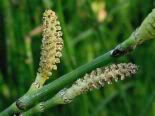

Scientific Name
Juncus effusus
Uses of Common Rush: Landscaping, Medicinal, Culinary, etc...
The dense stands that soft rush form have deep fibrous root systems, which provide very good shoreline protection, filter suspended solids, up-take nutrients, and facilitate substrate oxidation. With its low pH and metal tolerances, soft rush often survives polluted conditions. The seed and vegetative parts of soft rush are utilized by waterfowl, muskrats, non-game birds, moose and domestic livestock for food or cover. The stems of this grass-like plant have been traditionally used for making floor mats, and chair seats.
General Characteristics
Juncus effusus is a slow spreading, clump forming, grass-like perennial which emerges from a stout branching rootstock. The short, finely divided rhizomes are 6 to 10 inches long, growing from 1/4 to 2 inches beneath the soil surface. The culms are smooth, erect, bright green and hollow, with reduced basal leaves. New shoots emerge and develop in late summer, reaching up to 4 feet tall at maturity the following spring.
The flowers are inconspicuous and are 1 to 4 inches long. The flowers emerge and mature from March to September, peaking in July. Pollination typically occurs by wind, but occasionally it is by insects. A three celled obovoid capsule develops after fertilization, which contains many small (.02 to .025 inch long) straw colored seeds. There are an estimated 18,000,000 seeds per pound. Due to the small size and tacky outer coating, the seed of Juncus effusus can be disseminated by wind, water or animals. After shatter, seeds may remain viable for greater than 60 year if over-topped with sediments.
Required Growing Conditions
Soft rush is naturally found throughout the temperate and sub-tropical areas of North America, Europe, and Asia, with the exception of the arid and high altitude regions. It inhabits fresh to brackish marshes, swamps, ditches, and moist seasonal wetlands and meadows. Soft rush is tolerant of diverse site conditions, but thrives in direct sun, finely textured soils, salinity less than 14ppt., pH from 4.0 to 6.0, and shallow water (less than 6 inches).
Common rush is distributed throughout most of the United States.
Cultivation and Care
Juncus effusus can be easily grown from seed or vegetative divisions, but seed dispersal is the primary means of natural reproduction. For germination to occur seed must be in contact with moist soil, receive direct sunlight, and over-winter on the soil surface. As long as moist conditions can be sustained and early competition reduced, seedlings will develop the following spring. Nursery and greenhouse production are effectively accomplished with seed or vegetative divisions. High seedling emergence can be expected under the controlled environment of the greenhouse. Moist stratification improves germination of soft rush. Stem divisions (bare root and containerized)are reliable when planted on adequate sites before mid-June. Greenhouse produced containerized stock can be ready for field planting 6 weeks after transplanting. Two year old clumps of soft rush will yield an average of 80 planting units. A planting unit should contain 3 to 5 culms. They can be planted by hand or mechanically.
General Upkeep and Control
Soils with low content of organics or fines will have good production if 300 to 500 lbs per acre per year of 10-10-10 commercial fertilizer are applied. Annual draw down periods must be scheduled to maintain vegetative parts and encourage seedling establishment of soft rush.
Cultivars, Improved, and Selected Materials (and area of origin) No improved varieties are known, but numerous wetland nurseries carry local or regional ecotypes.





0 comments: